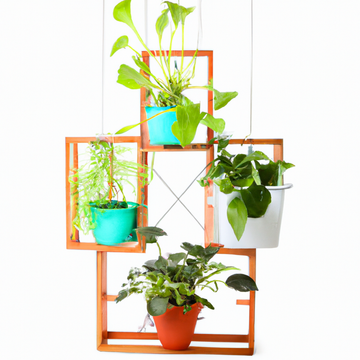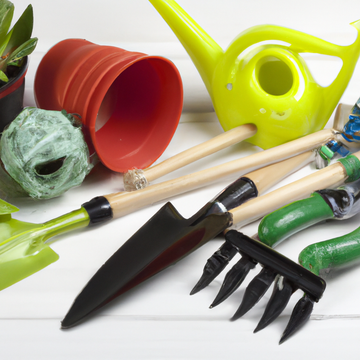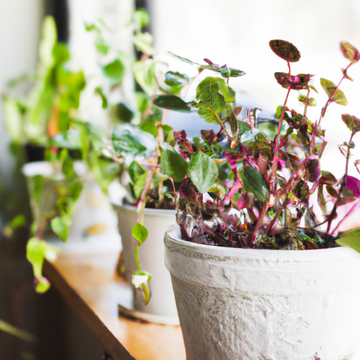Elevate Your Indoor Greenery: Exploring the World of Indoor Planters
by GOLDDUST- Rethink&Revive on Jun 21, 2023

Introduction to Indoor Planters
Looking to add a touch of greenery to your indoor space? Indoor planters are the perfect solution! With so many types, materials, and creative ways to display them, there's an indoor planter for every style and space. In this article, we'll explore the world of indoor planters and give you tips on how to elevate your indoor greenery game!
Types of Indoor Planters
Indoor planters come in various shapes and sizes, making it easy to find one that suits your style and needs. Here are the most common types of indoor planters:
Hanging Planters:
As the name suggests, these planters hang from the ceiling or a higher surface using hooks or chains. They are perfect for showcasing cascading plants like ivy or ferns.
Hanging planters are a great way to add greenery to your indoor space while also saving on floor space. They come in various sizes and shapes, making it easy to find the perfect one for your home decor.
One of the benefits of hanging planters is that they can be placed anywhere - from windowsills to high ceilings. This makes them a versatile option for any room in your house.
When choosing a hanging planter, consider the weight of your chosen plant. Some materials like ceramic or glass may not be able to hold heavier plants, whereas metal or wicker baskets could handle more substantial foliage.
Another aspect to consider when selecting a hanging planter is its drainage system. Make sure that it has adequate drainage holes at the bottom so that water doesn't accumulate and cause damage.
Get creative with how you display your hanging planters! Try grouping together different sizes and styles for an eye-catching display above a sofa or dining table.
Wall Planters:
These planters attach directly to a wall and can be arranged in different configurations to create beautiful living walls. They usually have multiple planting pockets, allowing you to grow several plants at once.
Wall planters are a great way to elevate your indoor greenery while also saving space. These planters come in various shapes and sizes, making them perfect for any home decor.
One popular type of wall planter is the hanging pocket planter. This style uses small pockets that can hold small plants such as succulents or herbs. They can be hung on walls to create a living wall effect, adding life and color to your space.
Another type of wall planter is the modular system which allows you to customize the size and layout according to your needs. These usually consist of individual pots that can be mounted onto a panel or grid system, allowing you to create unique designs with multiple plants in one place.
If you're looking for something more traditional, there are also single pot designs available that simply mount onto a wall like a picture frame. These types of planters are perfect for showcasing larger plants such as ferns or snake plants.
Whether you prefer modern or classic styles, there's no denying that wall planters add character and charm to any room in your house. So why not try incorporating them into your indoor gardening setup today?
Traditional Planters:
The classic planter is free-standing with a wide base and an open top. These versatile containers can hold any type of houseplant you desire - from small succulents to large tropical trees.
Traditional planters are a classic option for adding greenery to your indoor space. These types of planters come in various shapes and sizes, making them versatile enough to fit any design aesthetic. One popular type of traditional planter is the terra cotta pot, which comes with a rustic charm that can add warmth to your living area.
Another common type of traditional planter is the glazed ceramic pot. These pots come in an array of vibrant colors and designs that can make a statement in any room. Traditional planters also include wicker baskets or woven containers made from natural materials like bamboo or rattan.
One advantage of using traditional planters is their durability, as they are often made from sturdy materials like clay, stone or metal. They require minimal maintenance and can withstand extreme temperatures without cracking or breaking.
When choosing a traditional planter for your indoor greenery, consider the style and color scheme you want to achieve in your space. Whether it's modern, vintage or bohemian-inspired decor, there's always a perfect match for every design preference.
Traditional planters offer timeless appeal that never goes out of style. They're versatile enough to be used as statement pieces on their own or mixed with other decorative elements such as shelves and wall art to create unique displays for your plants.
Materials Used In Indoor Planters:
Ceramic Planters:
Ceramic pots are popular because they come in many colors, finishes, patterns and styles, which adds texture to any room's décor
Ceramic planters are a popular choice for indoor plants due to their versatility and durability. They come in various shapes, sizes, and colors that can fit any style or theme of interior design. One great advantage of ceramic planters is that they retain moisture well, which helps keep the soil moist and healthy.
Another benefit of ceramic planters is their aesthetic appeal. They have a smooth surface finish that gives them an elegant look which complements different types of houseplants. Ceramic pots also come in different patterns such as geometric shapes or intricate designs making them ideal statement pieces for your home decor.
When choosing a ceramic planter, it's important to consider its size relative to the plant you intend to put inside it. A container too small can stunt growth while one too large may lead to over watering. Additionally, ensure that there's adequate drainage at the bottom so water doesn't accumulate and cause root rot.
Proper care will extend the life-span of your ceramic planter ensuring it lasts long enough for you to enjoy its beauty without having to replace it often.
Wooden Planters:
These eco-friendly options add warmth and texture while providing excellent insulation for your plants' roots.
Wood planters are a popular choice for indoor greenery enthusiasts due to their natural and rustic aesthetic. They come in different shapes, sizes, and finishes that can fit any interior design style.
One of the advantages of using wood planters is their durability and versatility. Wood is a sturdy material that can withstand wear and tear from soil moisture and sun exposure over time. Moreover, it's easy to customize wood planters by painting or staining them to match your room decor or personal preference.
Another benefit of using wood planters is their ability to regulate moisture levels properly, which can enhance the growth rate and health condition of your plants. Since wood is porous by nature, it allows air circulation around the roots while retaining enough water content in the soil.
If you're looking for sustainable options for your indoor garden, then choosing wooden planters may be an excellent option since they're biodegradable materials that have a minimal environmental impact compared to plastic or ceramic pots.
Incorporating wooden planters into your home decor can elevate both its beauty and functionality while providing a green oasis inside your living space.
Metal Planters:
Sleek metal designs bring modern vibes into indoor garden spaces. Metal-edged pots offer structural support for taller stems as well as high-end design aesthetics.
Metal planters are a popular choice for indoor gardening due to their durability and sleek appearance. These types of planters come in various shapes, sizes, and finishes that can fit any interior design style.
One type of metal planter is made from stainless steel, which is resistant to rust and corrosion. This makes it perfect for use in humid environments such as bathrooms or kitchens. Another type of metal planter is made from copper or brass, adding a touch of sophistication to any space.
Metal planters can also come with unique features such as intricate designs or embossed patterns that add texture and character to the planter itself. They can be used on their own or paired with other materials like wood or concrete to create an interesting contrast.
When choosing metal planters for your indoor garden, consider the size and shape of the container along with its drainage system. Some metals may not be suitable for certain plants due to potential chemical reactions between soil components and the material.
Metal planters provide an elegant option for displaying your favorite plants indoors while offering long-lasting durability at the same time.
Glass Planters:
Clear glass vessels allow you to see every detail of your botanical display by creating dramatic visual effects such as magnifying light rays or refracting them in new ways
When choosing an indoor planter, consider factors like size/proportion; matching pot with appropriate-sized plants; the material used (ceramic vs wood vs metal); color schemes that complement other décor items around them (such as furniture upholstery).
By selecting an appropriate container style based on these considerations mentioned above ensure the best possible environment for growing healthy houseplants indoors!
Glass planters are a beautiful and sophisticated way to display your indoor plants. They come in different shapes, sizes, and designs that can add an elegant touch to any space. One of the benefits of glass planters is that they allow you to see the roots of your plants grow and develop.
One type of glass planter is the terrarium. Terrariums are usually made from clear glass or plastic containers that create a mini-ecosystem for your plants. The enclosed environment allows for humidity regulation, making them ideal for tropical plants like ferns.
Another type of glass planter is a hanging orb-shaped container which typically comes with a hook or chain attachment. These hanging planters are perfect for small succulents or air plants since they require minimal watering.
A popular trend in using glass planters as decorative accents in homes involves filling them with sand, pebbles, colored stones, or even seashells before adding the soil and plantings on top - creating unique layers within your planter.
Glass Planters offer versatility & elegance when it comes to displaying indoor greenery; their transparency adds dimensionality while allowing light to shine through from all angles!
Choosing the Right Indoor Planter for Your Space
Choosing the right indoor planter for your space is crucial to creating a harmonious and cohesive interior design. When selecting an indoor planter, begin by considering the proportion of your room and existing decor. A large plant in a small room can overwhelm the space, while a tiny one in a spacious area may be lost.
Next, consider matching plants with planters. Different plants thrive in different environments, so choose an indoor planter that suits both its aesthetics and growing needs. For example, succulents are best suited to shallow containers with good drainage.
Another factor to consider when choosing an indoor planter is the material it's made of. Ceramic pots are popular because they come in various shapes and sizes while also being durable enough for long-term use indoors. Wood planters offer natural elegance while metal ones provide modernity; glass allows you to showcase roots growth.
Selecting an indoor planter comes down to personal style preference combined with practical considerations like size and shape appropriate for the chosen location as well as compatibility with houseplants' requirements of light exposure or available soil types within containers themselves
Size and Proportion
When it comes to choosing the right indoor planter, size and proportion are essential factors to consider. The size of your planter should be proportional to the space available in your home. A large planter may be suitable for a spacious living room, but it may overwhelm a smaller area like a bedroom or bathroom.
Choosing the correct height is also important, as you want to ensure that your plants don't overpower their surroundings. If you have low ceilings, tall planters may not be appropriate; instead consider shorter and wider options.
Proportion should also factor into selecting an indoor planter based on its contents. Be sure that your chosen pot can support not only the weight but also accommodate future growth of the plant inside it.
Make sure your indoor planters complement each other while serving different purposes in enhancing visual appeal and beauty within spaces throughout your home!
Matching Planters with Plants:
Choosing the right planter for your indoor plants can be just as important as choosing the right plant. The right pairing of plant and planter can not only enhance the beauty of both but also promote healthy growth.
Consider the size, color, and texture of both the plant and planter when making a choice. A large leafy tropical plant would look great in an oversized terracotta pot, while a delicate succulent could thrive in a small ceramic planter that complements its size.
The material is another factor to consider when matching plants with their perfect planter. A sleek metal or glass container may suit a modern-looking plant like an air-purifying snake plant, while rustic wood or woven baskets would complement earthier options like ferns or spider plants.
Be mindful of drainage requirements too. Certain plants require well-draining containers to avoid root rot and fungal infections that can harm them over time. Choose pots with drainage holes at their bottoms if this is necessary for your chosen greenery.
Choosing the ideal planter for indoor plants comes down to finding harmony between form and function. Get creative by mixing different colors, sizes, textures, materials - whatever suits your taste!
Creative Ways to Display Indoor Planters
One of the best parts about decorating with indoor planters is the endless opportunities for creative display. Here are a few ideas to get your imagination flowing.
First, consider grouping multiple planters together in varying sizes and shapes to create a visually interesting cluster. You can even mix and match different materials like ceramic, wood, and metal for added texture.
Another fun way to display indoor plants is by creating a mini garden within one large planter. Choose plants that have similar light and watering needs, arrange them creatively within the pot, and voila - you've got your own little green oasis!
For those short on floor space, wall-mounted planters offer a great solution. Hang them at varying heights or arrange several in a row for an eye-catching living wall effect.
Don't be afraid to think outside the box when it comes to displaying indoor planters! Get creative with repurposed items like vintage teapots or old light fixtures as unique vessels for your greens. The possibilities are truly endless!
Grouping Planters Together
Grouping planters together is a great way to create an eye-catching display in your home. By placing multiple indoor planters in one area, you can add depth and dimension to your space.
When grouping planters together, it's important to consider the size and shape of each planter. You want to make sure that they complement each other without looking too cluttered or overwhelming.
One idea for grouping indoor planters is to use different heights. For example, place a tall floor planter next to a shorter table planter for added visual interest.
Another option is to group plants with similar colors or textures together. This creates a cohesive look while still allowing each individual plant to shine.
If you have limited space, consider using wall-mounted planters or hanging baskets as part of your grouping. This not only saves floor space but also adds height and dimension to your display.
There are endless possibilities when it comes to grouping indoor planters together. Get creative and experiment with different combinations until you find the perfect arrangement for your home!
Creating a Mini Indoor Garden
Creating a mini indoor garden is a great way to bring the beauty of nature into your home. It's also an opportunity to care for and nurture plants that can provide many benefits, including improved air quality, reduced stress levels, and enhanced mood.
To create a mini indoor garden, consider grouping several small plants together in one area. You can use different types of planters or containers to add visual interest and texture. For example, you could place succulents in terrariums or arrange herbs in mason jars.
Another option is to hang small planters from the ceiling or wall using hooks or brackets. This not only adds greenery but also helps free up floor space.
When selecting plants for your mini indoor garden, choose varieties that thrive indoors with low light conditions such as snake plants and pothos vines. Also, make sure they have similar watering needs so you don't overwater some while underwatering others.
Get creative with your display! Consider adding decorative rocks or other natural elements like shells or driftwood around your planters to complete the look of your own personal mini oasis inside your home.
Conclusion: Elevate Your Space with Indoor Planters
Elevating your indoor greenery with the world of indoor planters is a simple yet effective way to transform your space. From hanging and wall planters to traditional options, there are various types of indoor planters that can fit any style or preference. Choosing the right planter for your space involves considering size, proportion, and matching it with the right plants.
By using materials like ceramic, wood, metal or glass, you can add texture and depth to your interior design while still providing functionality. You can also get creative with how you display your indoor planters by grouping them together or creating a mini garden in one area.
Indoor plants not only bring a touch of nature into our homes but also provide numerous benefits such as improving air quality and reducing stress levels. So why not elevate your space today with some beautiful indoor planters? With so many options available on the market now, there’s never been an easier time to start incorporating more greenery into our daily lives.




